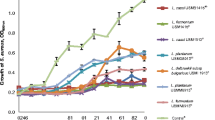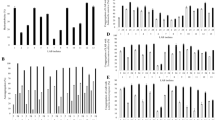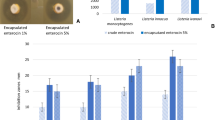Abstract
This paper aimed to investigate the ultra structure ofStaphylococcus aureus EPS and describe the changes that occurred following exposure to pasteurisation, sodium benzoate preservation and treatment with a bacteriostatic hand cleanser. Mass spectrometry was employed to identify and monitor the presence and distribution of certain saccharides and fatty acid constituents. Fatty acid and saccharide profiles demonstrated that the ultra structure was subject to change and diversification as a result of exposure. Components generally associated with Gram-negative LPS, 2-keto-3-deoxy-octulosonic acid (KDO) and β-hydroxy fatty acids, were also identified in the EPS ofS. aureus.
Similar content being viewed by others
References
Abraham M., Venter P., Lues J.R.F., Ivanov I., de Smidt O. (2009). Changes in lipopolysaccharide related endotoxicity of food-borne pathogens in response to safety treatments practiced in South Africa. British Food Journal, 111: 528–538.
Asperger H. (1994).Staphylococcus aureus. In: The Significance of Pathogenic Microorganisms in Raw Milk. International Dairy Federation, Brussels, pp. 24–42.
Bergdoll M.S. (1989).Staphylococcus aureus, Marcel Dekker, Inc., New York.
Bohin A., Bouchart F., Richet C., Kol O., Leroy Y., Timmerman P., Huet G., Bohin J.P., Zanetta J.P. (2005). GC/MS identification and quantification of constituents of bacterial lipids and glycoconjugates obtained after methanolysis as heptafluorobutyrate derivatives. Analytical Biochemistry, 340: 231–244.
Bryn K., Jantzen E. (1982). Analysis of lipopolysaccharides by methanolysis, trifluoroacetylation, and gas chromatography on a fused-silica capillary column. Journal of Chromatography, 240: 405–413.
Jantzen E., Froholm L.O., Hytta R., Bovre K. (1972). Gas chromatography of bacterial whole cell methanolysates. I. The usefulness of trimethylsilyl- and trifluoroacetyl-derivatives for strain and species characterization. Microbiology and Immunology, 80: 660–671.
Le Loir Y., Baron F., Gautier M. (2003).Staphylococcus aureus and food poisoning. Genetics and Molecular Research, 2: 63–76.
Meadow P.M. (1975). Wall and Membrane Structures in the GenusPseudomonas, John Wiley, Chichester, UK.
Morath S., Geyer A., Hartung T. (2001). Structure-function relationship of cytokine induction by lipoteichoic acid fromStaphylococcus aureus. Journal of Experimental Medicine, 193: 393–397.
Morath S., Stadelmaier A., Geyer A., Schmidt R.R., Hartung T. (2002). Synthetic lipoteichoic acid fromStaphylococcus aureus is a potent stimulus of cytokine release. Journal of Experimental Medicine, 195: 1635–1640.
Morath S., von Aulock S., Hartung T. (2005). Structure/function relationships of lipoteichoic acids. Journal of Endotoxin Research, 11: 348–356.
Moss C.W., Dees S.B. (1975). Identification of microorganisms by gas chromatographic-mass spectrometric analysis of cellular fatty acids. Journal of Chromatography, 112: 594–604.
Saraf A., Larsson L., Burge H., Milton D. (1997). Quantification of ergosterol and 3-hydroxy fatty acids in settled house dust by gas chromatography-mass spectrometry: comparison with fungal culture and determination of endotoxin by a Limulus amebocyte lysate assay. Applied and Environmental Microbiology, 63: 2554–2559.
Schmitt M., Schuler-Schmid U., Schmidt-Lorenz W. (1990). Temperature limits of growth, TNase and enterotoxin production ofStaphylococcus aureus strains isolated from foods. International Journal of Food Microbiology, 11: 1–19.
Tamarapu S., McKillip J.L., Drake M. (2001). Development of a multiplex polymerase chain reaction assay for detection and differentiation ofStaphylococcus aureus in dairy products. Journal of Food Protection, 64: 664–668.
Venter P., Lues J.F. (2003). Extraction methods for lipopolysac-charides fromEscherichia coli ATCC 25922 for quantitative analysis by capillary electrophoresis. International Journal of Food Microbiology, 84: 245–250.
Venter P., Abraham M., Lues J.F., Ivanov I. (2006a). Influence of commercial sanitizers on lipopolysaccharide production bySalmonella enteritidis ATCC 13076. Journal of Food Protection, 69: 2889–2895.
Venter P., Abraham M., Lues J.F.R., Ivanov I. (2006b). The influence of sanitizers on the lipopolysaccharide composition ofEscherichia coli O111. International Journal of Food Microbiology, 111: 221–227.
Ward J.B. (1981). Teichoic and teichuronic acids: biosynthesis, assembly, and location. Microbiology Reveiws, 45: 211–243.
Weber J.R., Moreillon P., Tuomanen E.I. (2003). Innate sensors for Gram-positive bacteria. Current opinion in Immunology, 15: 408–415.
West T.E., Lewis B.A., Apicella M.A. (1987). Immunological characterization of an exopolysaccharide from theStaphylococcus aureus strain Smith diffuse. Journal of General Microbiology, 133: 431–438.
Yuste J., Fung D.Y.C. (2003). Evaluation ofSalmonella typhimurium, Yersinia enterocolitica andStaphylococcus aureus counts in apple juice with cinnamon, by conventional media and thin agar layer method. Food Microbiology, 20: 365–370.
Author information
Authors and Affiliations
Corresponding author
Rights and permissions
About this article
Cite this article
Abraham, M., Venter, P., Lues, J. et al. The exopolysaccharide (EPS) ultra structure ofStaphylococcus aureus: changes occurring in EPS resulting from exposure to physical and chemical food preservation practises in South Africa. Ann. Microbiol. 59, 499–503 (2009). https://doi.org/10.1007/BF03175137
Received:
Accepted:
Issue Date:
DOI: https://doi.org/10.1007/BF03175137




